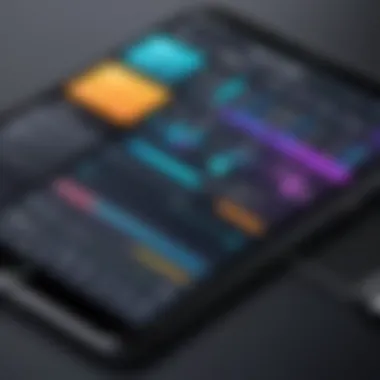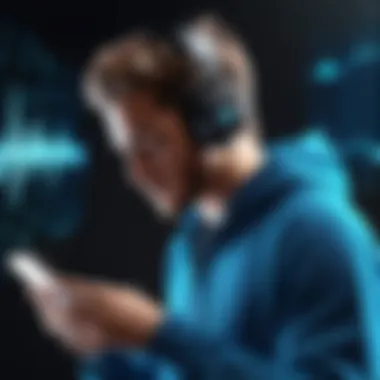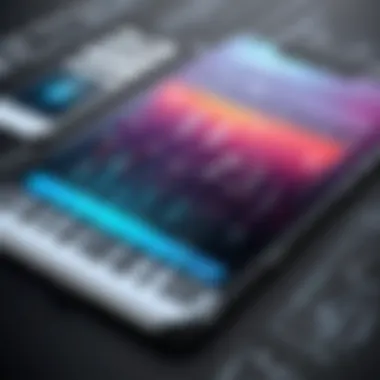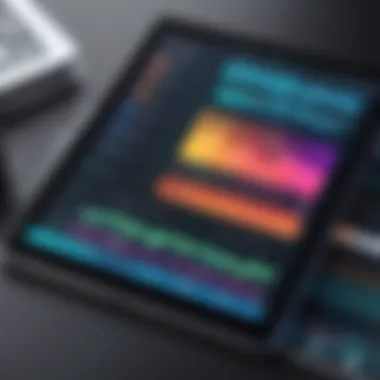Top Music Composing Apps: Features and Insights


Intro
In today’s rapidly evolving world of technology, musicians find themselves at a seemingly infinite crossroads of creativity and innovation. Music composing applications are no longer just simplistic tools; they are sophisticated platforms that enable both budding and seasoned artists to unleash their creative potential. The intimacy of mobile devices, combined with powerful features, offers new avenues for artistic expression. However, as the market has grown, so has the bewildering array of options available. It makes sense to dissect what’s out there, why they matter, and how to choose the best fit.
By diving deeper into these apps, musicians can uncover unique features tailored for various genres, whether one prefers orchestral, electronic, or even experimental music. In this exploration, we will also navigate through user experiences, shedding light on why certain tools resonate more with some artists than others. Ultimately, the goal is to empower musicians, giving them the information they need to select software that meets their artistic needs and enhances their music creation process.
Technological advancements are shaping how music is created and experienced today, and understanding this landscape is invaluable for creative minds. As we embark on this voyage, we’ll highlight everything from app specifications to real-world usability.
"The future of music is not just in the hands of the musicians but also in the technology they choose to wield."
Let’s kick things off with an overview of some of the top music composing apps to consider in this digital symphony.
Prelude to Music Composition Apps
Diving into the realm of music composing applications is akin to unlocking a treasure chest filled with possible melodies, rhythms, and creative tools. In an age where technology dances hand in hand with artistic expression, these apps have transformed the landscape of music creation. They cater to a wide spectrum of musicians, from the passionate hobbyist crafting tunes in a garage to the seasoned producer refining their next chart-topping hit in a professional studio.
At their core, music composition apps provide a platform for users to translate their sonic visions into reality. The importance of these tools can’t be overstated. They democratize music-making, allowing anyone with a smartphone or computer to compose, edit, and share their work without the heavyweight of expensive hardware or intricate equipment setups. Benefits range from accessibility to an array of features that can foster collaboration and innovation in ways previously unimaginable.
Defining Music Composition
Music composition is not just an act; it's a process that encompasses various elements such as melody, harmony, rhythm, and texture. To compose means to deliberately put musical ingredients together to create a coherent piece. In this digital age, this involves using software that helps in structuring these components effectively. Whether it’s jotting down a catchy hook or arranging a full orchestral score, these apps facilitate the crafting of music that resonates with both the heart and mind.
The Rise of Digital Tools
The emergence of digital tools marked a significant shift in how music is produced. Gone are the days when one needed a professional studio for recording. With capabilities such as MIDI sequencing, virtual instruments, and audio editing all bundled in one application, aspiring musicians have a world of sound at their fingertips.
From the likes of GarageBand to FL Studio, a plethora of options exist. These tools are designed to be intuitive, even for those who may not have formal training. The rise of mobile apps also means that music composition isn't confined to a desk; creativity can flourish at a café, on the train, or anywhere the inspiration strikes.
"In today’s fast-paced world, a musician can harness creativity on-the-go, making every moment a potential spark for the next great composition."
In summary, the introduction of music composition apps has become paramount in understanding the modern music-making process. They redefine how music is approached, making it more inclusive, diverse, and accessible. As we delve deeper into the criteria for evaluating these apps, it’s essential to recognize that these tools are not just software; they are gateways to creativity.
Criteria for Evaluating Music Apps
When delving into the vast realm of music composing applications, a methodical approach to evaluation becomes essential. This article emphasizes several criteria that directly influence the effectiveness and usability of music apps. These factors can sway decision-making for both seasoned musicians and novices alike.
By assessing each criterion, users can ascertain which app best aligns with their musical ambitions and workflow preferences. These evaluations address the elements that can make or break the user experience, such as ease of use, sound quality, and compatibility with devices.
User Interface and Experience
A well-designed user interface (UI) can transform a daunting task into a smooth operation. When exploring music apps, the UI not only shapes immediate interactions but also impacts user satisfaction over time.
Ease of Navigation
Navigating a music composition app should feel like second nature. The ease of navigation is critical in determining how efficiently users can create and edit their projects. A clear layout, intuitive icons, and a logical flow are characteristics that users highly value.
For instance, apps that utilize stacked menus or straightforward toolbars can make the learning curve less steep. Users find it easier to access features such as recording, playing back, and mixing tracks. On the flip side, some apps might introduce a complex setup that could frustrate even experienced users, thus hindering the creative process.
Accessibility Features
Accessibility features in music apps are gaining increased attention. Not everyone has the same physical capabilities, and music apps that accommodate a range of users can widen their appeal.
By incorporating features like voice control, alternative keyboard shortcuts, and customizable color schemes, apps can cater to a broader audience. Apps like Noteflight have begun embracing these principles, ensuring that learning and creating music is inclusive for all. However, the nuances of implementing genuinely effective accessibility features can sometimes be a challenge for developers.
Functional Capabilities
Beyond user experience, the functional aspects of apps hold significant weight in their overall performance. Users must consider what tools and libraries a composition app offers to fulfill their creative desires.
Sound Libraries
Sound libraries form the backbone of many music apps, providing the necessary tools to create a diverse range of compositions. A robust sound library should include everything from acoustic instruments to synthesized sounds, giving composers options to experiment.
An app like GarageBand is well-regarded for its extensive sound library, allowing users to blend styles effortlessly. On the downside, some apps may offer a limited selection, trapping users in a box creatively, which could lead to repetitive soundscapes.


Editing Tools
Editing tools play a pivotal role in shaping the final product. High-quality editing features can make a significant difference in the composition process, enabling precise adjustments to notes, timing, and effects.
Many users appreciate applications that allow multi-track editing and real-time adjustments. However, a drawback can arise with apps that include overly complicated editing options, leading to confusion rather than enhancing the creative flow.
Collaboration Features
As music creation often thrives on collaboration, the ability to work alongside others is an increasingly sought-after feature. Collaboration tools allow multiple users to edit and contribute to a project in real-time, fostering creativity and innovation.
Apps that highlight collaboration successfully, like Noteflight, can inspire group projects and diverse contributions. Conversely, some applications may not cater well to collaborative efforts, which can be a disadvantage in today’s interconnected musical landscape.
Platform Compatibility
Ensuring that a music composition app can operate across various platforms is vital. Users often switch between devices; thus, seamless functionality can significantly enhance usability.
Mobile versus Desktop
The debate between mobile and desktop apps is becoming increasingly relevant. Many creators enjoy the flexibility of mobile apps for composing on-the-go, while desktop applications often provide more powerful editing capabilities.
Finding a balance—where an app offers essential mobile functionalities without sacrificing the depth typically found on desktops—can appeal to a wider audience. However, some apps are better suited to one platform than the other, which could limit user engagement.
Operating System Support
The need for varied operating system support cannot be overlooked. Users often rely on specific platforms, whether that be macOS, Windows, or mobile operating systems like iOS and Android. An app that operates across several systems ensures access to a larger demographic. However, incompatibility across platforms can restrict users, forcing them into narrow choices that might not fit their preferences.
Popular Music Composing Apps
When it comes to creating music today, the software we use can make a world of difference. Popular music composing apps serve as the backbone of the digital music revolution, enabling musicians at all levels to express their creativity like never before. These apps are not merely tools; they are gateways to a new realm of artistic possibility. From seasoned professionals to hobbyists dabbling in tunes on weekends, the right app can streamline the creative process and enhance overall productivity.
The significance of these apps lies in their diverse functionalities, from robust sound libraries to intuitive editing features. They not only cater to different musical styles but also adapt to the ever-evolving landscape of music production. It’s all about finding the right fit for one’s needs. As user demands shift, these apps bring in features such as cloud collaboration and mobile interfaces, making music-making a more accessible venture.
In essence, choosing the right music composing app can significantly amplify one’s musical experience. With various options available, users must evaluate what aligns best with their artistic ambitions and workflows.
GarageBand
Overview and Features
GarageBand stands tall among the pioneers of user-friendly music composition applications. One of its standout features is the ease of use, which makes it a prime choice for beginners. The interface feels like a digital playground where one can mix and match tracks with ease. It comes packed with a plethora of virtual instruments and loops that can breathe life into even the most rudimentary compositions.
For instance, its Smart Controls feature allows users to adjust sounds effortlessly, giving them a professional feel without needing extensive knowledge. This characteristic is not just beneficial; it’s often hailed as a game-changer for novices trying to get their feet wet in the world of music creation.
However, the app is not without its drawbacks. Many seasoned musicians find that, while it’s fabulous for basic projects, it lacks depth in high-level editing and arrangement capabilities compared to professional software.
Target Audience
GarageBand appeals primarily to hobbyists and beginners, making it an entry point for many aspiring musicians. The simplicity of its design allows users to jump right in, unleashing creativity with minimal barriers. This key characteristic—the accessibility and low learning curve—positions GarageBand as an excellent introduction to digital audio workstations.
The unique advantage here is that it’s free for macOS and iOS users, providing a cost-effective entry into music composition. On the flip side, those seeking advanced features or multi-track recording may feel constrained as their skills evolve.
Strengths and Limitations
GarageBand indeed shines with its user-friendly interface and a rich library of sounds. This makes it a strong contender in the lineup of music composing apps. Musicians appreciate how this app streamlines the composition and editing processes, fostering creativity. However, its limitations become apparent when users outgrow the capabilities as they gain proficiency.
Advanced audio routing and professional quality outputs, often desired by more experienced users, may prove to be a challenge with GarageBand. As great as the app is for starters, it may not satisfy the needs of seasoned professionals looking for intricate editing features or extensive sound design.
FL Studio
Key Features
FL Studio is often deemed the heart of electronic music production. Its distinctive pattern-based workflow is designed for efficiency, making it particularly attractive for electronic genre enthusiasts. What distinguishes it is the Piano Roll, a drag-and-drop function that grants users complete control over their compositions.
One unique aspect is its built-in plugins, which provide an array of instruments and effects readily available. This versatility makes it a popular choice for producing beats and complex arrangements. However, it might overwhelm novices due to the steep learning curve associated with mastering its full functionality.
User Community


The FL Studio user community is vibrant and extensive, reaching across various platforms including Reddit and Facebook. This characteristic of having a supportive network is invaluable for users. They can share tips, resources, and even collaborate on projects, enhancing the overall experience.
However, a downside might be the sheer volume of information and tutorials available, which can be both a blessing and a curse. New users may feel lost amid the multitude of resources, making it challenging to find direction at first.
Best Use Cases
FL Studio is particularly well-suited for genres like electronic, hip-hop, and even pop music. The capability to handle multiple tracks efficiently while maintaining sound integrity is a huge advantage for producers. This software's real-time composition method allows for spontaneous creativity, necessary for electronic genres.
Nonetheless, those looking to compose classical pieces or intricate orchestral arrangements may find FL Studio less accommodating, as its strengths lie elsewhere.
Ableton Live
Performance Mode
One of the standout features of Ableton Live is its Performance Mode, which is ideal for live music settings. The mode allows musicians to remix and manipulate tracks in real time, creating an interactive performance experience that engages both the artist and the audience. This element can transform a conventional gig into a dynamic musical journey.
The downside here, however, is that not everyone requires such live capabilities, which can make the app feel unnecessarily complex for studio recording purposes.
Session View Explained
The Session View in Ableton Live is a unique interface allowing for a non-linear approach to composition. This versatility enables artists to experiment with various loops and clips without the constraints of a traditional timeline. Many find this approach liberating and conducive to creativity.
Yet, it may not be user-friendly for individuals who prefer a straightforward arrangement. Those fresh to this workflow may need time to adapt, which could become a point of frustration.
Integration with Hardware
Ableton Live excels in its integration with hardware controllers. This functionality allows musicians to expand their creative possibilities, making it easier to incorporate physical instruments or controllers during live sessions or recordings.
Unfortunately, this hardware reliance could become a drawback for some; if users prefer a fully software-based approach, they might feel limited by the need for additional gear or investment.
Logic Pro
Advanced Editing Tools
With advanced editing tools, Logic Pro X is a heavyweight in the music composition sphere. It provides an array of multi-track editing capabilities that appeal to professionals seeking precision. Musicians can manipulate audio and MIDI tracks in ways that meet intricate production needs, making it a well-rounded tool.
However, the feature-rich environment could be intimidating for new users as it might require significant time and effort to fully leverage its potential.
Comprehensive Sound Library
Logic Pro X boasts a comprehensive sound library that caters to a wide variety of genres and styles. This extensive library enables musicians to tap into a vast range of sounds, inspiring diverse musical creations.
On the other hand, the abundance of options might be overwhelming, especially for those who prefer simplicity and quick access to specific sounds.
User Skill Level Required
Focusing on user skill level, Logic Pro X is ideal for intermediate to advanced users. This characteristic ensures that it maintains a serious tone in music production, attracting serious musicians looking for depth in software capabilities.
However, beginners might find the steep learning curve discouraging, particularly if they’re not familiar with digital audio workstations.
Noteflight
Web-Based Composition
Noteflight stands out with its web-based composition features, offering an easily accessible platform for musicians to compose directly in their browsers. This characteristic captures the essence of modern music-making by allowing for immediate collaboration without requiring hefty software downloads.
Nevertheless, the online platform may hinder access when internet connectivity is sluggish, impacting performance during critical sessions.
Educational Usage
Noteflight shines brightly in educational usage. Many music educators utilize this tool for student compositions, providing a hands-on experience for learners. This aspect not only streamlines the teaching process but also encourages creativity among students.
However, its features could be too simplistic for advanced musical instruction, leaving room for enhancement in advanced music theory applications.
Collaborative Features


The collaborative features of Noteflight enable users to share their compositions easily and receive feedback in real-time. This accessibility allows for a community of musicians to grow and learn together, which can be a powerful encourage in a musician's journey.
Yet, the collaborative nature may also lead to interruptions or distractions, potentially impacting the creative process depending on how users prefer to work.
Emerging Trends in Music Composing Applications
With the rapid technological innovations and changing consumer habits in recent years, the landscape for music composing applications is continually evolving. This section aims to delve into the latest trends shaping these tools, revealing their implications for creators and listeners alike. Understanding these trends is crucial for musicians looking to stay ahead in a competitive field and leverage the latest features to enhance their creative process.
Artificial Intelligence in Composition
AI-Powered Tools
The advent of artificial intelligence is a game changer, especially in music composition. AI-powered tools are designed to assist in creating music in ways that were previously unimaginable. These unique tools can analyze vast amounts of music data to suggest melodies, harmony, and even lyrics. One of the key characteristics of AI-powered tools is their ability to learn from the user’s input, tailoring recommendations as they analyze the user's style.
For example, tools like Amper Music and AIVA allow users to generate entire musical tracks in mere minutes. The ease of use and speed of these tools make them attractive for both novices and seasoned musicians wanting to quickly flesh out ideas. However, while AI offers efficiency, it raises questions about the authenticity of the creative process and whether music created primarily by AI can capture human emotions fully.
Impact on Creativity
The impact of AI on creativity can be a double-edged sword. On one hand, these tools can foster innovation by freeing up time for musicians to experiment with their sound, thus broadening their musical horizons. AI can suggest ideas or arrangements that the musician might not have thought of otherwise. This characteristic makes AI a dynamic ally in the creative process.
On the other hand, there is a concern that over-reliance on these tools could stifle individual expression. Some claim that it might lead to homogenization of music, where originality takes a back seat to algorithmic trends. Thus, while embracing AI's potential, musicians must remain vigilant about maintaining their unique voice in the noise of technological advancement.
Mobile Composition Trends
On-the-Go Music Creation
Today's musicians are increasingly creating music on-the-go, thanks to mobile composition tools. This trend reflects a broader shift towards flexibility and convenience in the creative process. Mobile apps allow musicians to capture ideas as they spontaneously occur, anytime and anywhere. The key characteristic here is portability—having powerful apps like GarageBand or FL Studio Mobile empowers users to compose tracks during their daily commutes, in cafes, or even while traveling.
Many features in these mobile apps are tailored for quick and intuitive use, making them beneficial for fast-paced lifestyles. However, some may find the smaller screens and limited processing power compared to desktop applications a disadvantage, potentially restricting more complex projects.
User Engagement
User engagement has also surged in the mobile music composition space. The interactivity of modern apps allows for features that invite users to participate in their music-making experience. In-app tutorials and community challenges not only enhance the learning curve but also encourage users to showcase their compositions. This aspect of engagement creates a sense of belonging and motivates users to hone their skills and share their creations.
High user engagement keeps the creative juices flowing, thereby fostering a vibrant community around mobile music composition. Still, there is a flip side, as some users may find themselves distracted by incessant updates or the lure of social media integration that competes for their attention.
Social Media Integration
Sharing Compositions
In the modern age, sharing compositions on platforms like SoundCloud or social media has become a norm. The integration of social sharing features allows users to readily showcase their work and gain invaluable feedback. This characteristic blends music creation with social interaction, making it remarkably popular amongst up-and-coming artists eager for exposure.
While this offers a brilliant opportunity for artists to build their audience, there are possible downsides, too. The pressure to create compositions that are 'share-worthy' could potentially detract from the authenticity and true artistic expression, as musicians might feel compelled to conform to popular trends.
Community Building
Social media integration also plays a crucial role in community building among musicians and enthusiasts. Online communities can foster collaboration, inspiration, and support, essential for artists navigating the often-isolated world of music creation. The unique feature of real-time feedback facilitates networking and mentoring opportunities in ways that weren’t achievable previously.
However, while the communal aspect can be enriching, it can also lead to an overwhelming amount of opinions and critiques, which may confuse or discourage some musicians. Balancing community input with personal vision is vital for growth and maintaining a sense of individuality in one's craft.
In sum, emerging trends in music composing apps are shaping a dynamic landscape. Musicians who understand and adapt to these trends can flourish by maximizing the tools available while remaining true to their artistic integrity.
Finale
The exploration of music composing apps draws attention to an ever-evolving landscape in the world of music production. In today’s digital age, more than just being a tool for professional studios, these applications have become the cornerstone for hobbyists and aspiring composers alike. By synthesizing various elements discussed in previous sections, it's clear how vital these tools are for bridging the gap between creativity and technology.
Summarizing Key Insights
Music composing apps are not simply software; they play a significant role in shaping the artistic journeys of countless musicians. In summary, we’ve encountered a variety of applications that cater to different needs, from GarageBand’s intuitive interface for beginners to Ableton Live’s robust features suited for live performances. Each app provides unique functionalities and capabilities that can significantly enhance the music creation process.
- User Experience: Intuitive interfaces improve the overall experience and accessibility for all skill levels.
- Functional Capabilities: Diverse sound libraries and editing tools empower musicians to experiment and innovate.
- Community and Support: Popular apps often come with vibrant communities and extensive resources, helping users troubleshoot and learn.
With these features in mind, users are equipped to make informed decisions tailored to their musical goals.
Future Outlook for Music Composition Apps
Looking towards the horizon, the future of music composition apps seems promising. Emerging trends such as artificial intelligence play a pivotal role in this evolution. AI-powered tools offer composers new means of exploration, allowing for unforeseen creativity in their workflows. Integrating AI can automate repetitive tasks, inspiring users to focus on the more nuanced aspects of music-making.
Moreover, as mobile technology continues to flourish, music composition apps must adapt to meet the demands of users who wish to create on-the-go. Enhancements in mobile compatibility and user engagement strategies will likely dictate the way apps evolve. Social media integration will also pivotally shape how musicians share and promote their work, creating communal spaces for feedback and collaboration.
Ultimately, as technology forges ahead, musician-centric innovations will blossom, ensuring that creativity remains at the forefront of music composition. Thus, the importance of understanding how these tools function and evolve is paramount for anyone passionate about music.



